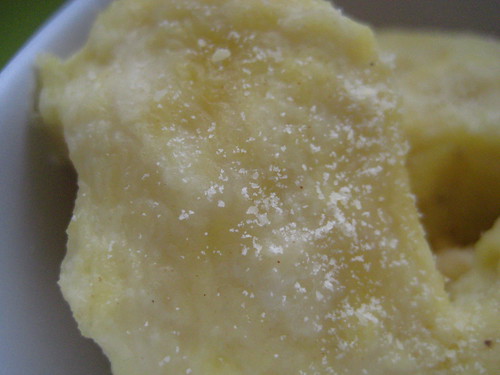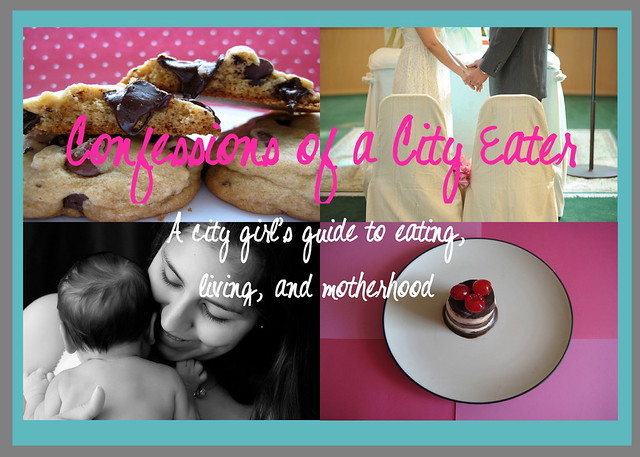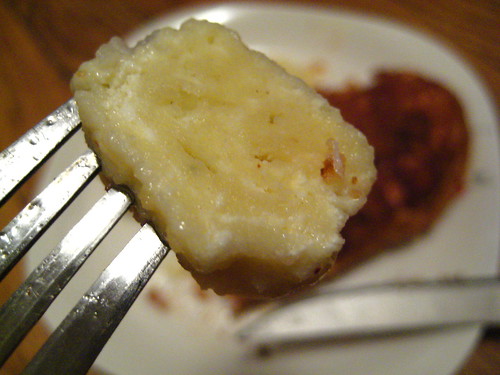 The past few days have been crazy and I completely forgot to post the first ever Daring Cook's challenge. My brain is still adjusting to not having to worry about school so I'm finding it hard to meet deadlines lately. I made the gnocchi and it came out delicious. It was the first time I have ever made gnocchi and I was afraid that it would be a huge waste of time because Alex has always thought gnocchi tasted like feet. Luckily enough, this did not taste like feet. It actually tasted like ricotta. The taste was soft and subtle and the sauce did not mask the or overwhelm the pasta. I served the gnocchi with a parmesan crusted chicken and the whole meal was delicious. Alex was super impressed and we were both extremely satisfied. Based on this first challenge I think my relationship with the Daring Cooks is going to be a good one. So good, I think you should head over to the Kitchen and join :)
The past few days have been crazy and I completely forgot to post the first ever Daring Cook's challenge. My brain is still adjusting to not having to worry about school so I'm finding it hard to meet deadlines lately. I made the gnocchi and it came out delicious. It was the first time I have ever made gnocchi and I was afraid that it would be a huge waste of time because Alex has always thought gnocchi tasted like feet. Luckily enough, this did not taste like feet. It actually tasted like ricotta. The taste was soft and subtle and the sauce did not mask the or overwhelm the pasta. I served the gnocchi with a parmesan crusted chicken and the whole meal was delicious. Alex was super impressed and we were both extremely satisfied. Based on this first challenge I think my relationship with the Daring Cooks is going to be a good one. So good, I think you should head over to the Kitchen and join :) Zuni Ricotta Gnocchi
Zuni Ricotta GnocchiSource: From The Zuni Café Cookbook.
Yield: Makes 40 to 48 gnocchi (serves 4 to 6)
Prep time: Step 1 will take 24 hours. Steps 2 through 4 will take approximately 1 hour.
For the gnocchi:
1 pound (454 grams/16 ounces) fresh ricotta (2 cups)
2 large cold eggs, lightly beaten
1 tablespoon (1/2 ounce) unsalted butter
2 or 3 fresh sage leaves, or a few pinches of freshly grated nutmeg, or a few pinches of chopped lemon zest (all optional)
½ ounce Parmigiano-Reggiano, grated (about ¼ cup very lightly packed)
about ¼ teaspoon salt (a little more if using kosher salt)
all-purpose flour for forming the gnocchi
For the gnocchi sauce:
8 tablespoons (227 grams/1/4 pound/4 ounces) butter, sliced
2 teaspoons water
Step 1 (the day before you make the gnocchi): Preparing the ricotta.
If the ricotta is too wet, your gnocchi will not form properly. In her cookbook, Judy Rodgers recommends checking the ricotta’s wetness. To test the ricotta, take a teaspoon or so and place it on a paper towel. If you notice a very large ring of dampness forming around the ricotta after a minute or so, then the ricotta is too wet. To remove some of the moisture, line a sieve with cheesecloth or paper towels and place the ricotta in the sieve. Cover it and let it drain for at least 8 hours and up to 24 hours in the refrigerator. Alternatively, you can wrap the ricotta carefully in cheesecloth (2 layers) and suspend it in your refrigerator for 8 to 24 hours with a bowl underneath to catch the water that’s released. Either way, it’s recommended that you do this step the day before you plan on making the gnocchi.
Step 2 (the day you plan on eating the gnocchi): Making the gnocchi dough.
To make great gnocchi, the ricotta has to be fairly smooth. Place the drained ricotta in a large bowl and mash it as best as you can with a rubber spatula or a large spoon (it’s best to use a utensil with some flexibility here). As you mash the ricotta, if you noticed that you can still see curds, then press the ricotta through a strainer to smooth it out as much as possible.
Add the lightly beaten eggs to the mashed ricotta.
Melt the tablespoon of butter. As it melts, add in the sage if you’re using it. If not, just melt the butter and add it to the ricotta mixture.
Add in any flavouring that you’re using (i.e., nutmeg, lemon zest, etc.). If you’re not using any particular flavouring, that’s fine.
Add the Parmigiano-Reggiano and the salt.
Beat all the ingredients together very well. You should end up with a soft and fluffy batter with no streaks (everything should be mixed in very well).
Step 3: Forming the gnocchi.
Fill a small pot with water and bring to a boil. When it boils, salt the water generously and keep it at a simmer. You will use this water to test the first gnocchi that you make to ensure that it holds together and that your gnocchi batter isn’t too damp.
In a large, shallow baking dish or on a sheet pan, make a bed of all-purpose flour that’s ½ an inch deep.
With a spatula, scrape the ricotta mixture away from the sides of the bowl and form a large mass in the centre of your bowl.
Using a tablespoon, scoop up about 2 to 3 teaspoons of batter and then holding the spoon at an angle, use your finger tip to gently push the ball of dough from the spoon into the bed of flour.
At this point you can either shake the dish or pan gently to ensure that the flour covers the gnocchi or use your fingers to very gently dust the gnocchi with flour. Gently pick up the gnocchi and cradle it in your hand rolling it to form it in an oval as best as you can, at no point should you squeeze it. What you’re looking for is an oval lump of sorts that’s dusted in flour and plump.
Gently place your gnocchi in the simmering water. It will sink and then bob to the top. From the time that it bobs to the surface, you want to cook the gnocchi until it’s just firm. This could take 3 to 5 minutes.
If your gnocchi begins to fall apart, this means that the ricotta cheese was probably still too wet. You can remedy this by beating a teaspoon of egg white into your gnocchi batter. If your gnocchi batter was fluffy but the sample comes out heavy, add a teaspoon of beaten egg to the batter and beat that in. Test a second gnocchi to ensure success.
Form the rest of your gnocchi. You can put 4 to 6 gnocchi in the bed of flour at a time. But don’t overcrowd your bed of flour or you may damage your gnocchi as you coat them.
Have a sheet pan ready to rest the formed gnocchi on. Line the sheet pan with wax or parchment paper and dust it with flour.
You can cook the gnocchi right away, however, Judy Rodgers recommends storing them in the refrigerator for an hour prior to cooking to allow them to firm up.
Step 4: Cooking the gnocchi.
Have a large skillet ready to go. Place the butter and water for the sauce in the skillet and set aside.
In the largest pan or pot that you have (make sure it’s wide), bring at least 2 quarts of water to a boil (you can use as much as 3 quarts of water if your pot permits). You need a wide pot or pan so that your gnocchi won’t bump into each other and damage each other.
Once the water is boiling, salt it generously.
Drop the gnocchi into the water one by one. Once they float to the top, cook them for 3 to 5 minutes (as in the case with the test gnocchi).
When the gnocchi float to the top, you can start your sauce while you wait for them to finish cooking.
Place the skillet over medium heat and melt the butter. Swirl it gently a few times as it melts. As soon as it melts and is incorporated with the water, turn off the heat. Your gnocchi should be cooked by now.
With a slotted spoon, remove the gnocchi from the boiling water and gently drop into the butter sauce. Carefully roll in the sauce until coated. Serve immediately.




4 comments:
Your gnocchi look fantastic!
Stephanie, these gnocchi look delicious!! I want to try making them for myself. Man oh man, if they converted Alex, then, certainly, they must be amazing. So glad you're done with 1L year! How exciting. Sorry that I’ve been an absent commenter; I just finished up my law school exams and am finally getting around to my google reader. (I know you understand ;) )
Your gnocchi looks amazing, as does the chicken. You need to post the recipe for that as well.
Those look just perfect. It was an interesting first challenge and one I didn't think i would like. But I was wrong. I even made some more today now that I have it right. Great job.
Post a Comment